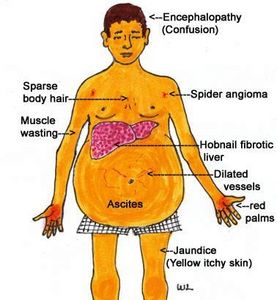
What is Cirrhosis?
What is Cirrhosis?
Cirrhosis is a condition of the liver. It is marked by scarring of liver tissues that results in blocked blood flow and impaired liver function.Cirrhosis is one of the leading causes of death by disease. Sadly, it kills more than 25,000 people per year.
The liver has several critical jobs, including the removal or neutralization of poisons in the body. This vital organ is also responsible for producing immune agents critical for controlling infection and removing bacteria and germs from the blood. The liver also produces proteins necessary for the regulation of blood clotting and makes bile for the absorption of fat and certain vitamins. A person cannot live without a functioning liver.
There are many causes of cirrhosis. Disease, drug use, infection, heavy alcoholic drinking, exposure to certain toxins, and blocked bile ducts can cause damage to the liver and lead to cirrhosis. Among the known causes of this condition, chronic alcoholism and Hepatitis C are the most common in the United States.
A person can have cirrhosis without immediately exhibiting symptoms of the condition. Over time, however, healthy cells are replaced with scar tissue and liver function is reduced. As liver function begins to fail, symptoms of exhaustion, loss of appetite, nausea, and weight loss may become evident. The affected individual may also experience weakness, abdominal pain, and spider-like blood vessels on the skin.
As cirrhosis progresses, complications may develop. These complications may include edema, ascites, bruising, bleeding, jaundice, itching, and gallstones. Other complications can include toxins in the blood or brain, medication sensitivity, portal hypertension, varices, insulin resistance, type 2 diabetes, and liver cancer. Additionally, a person with cirrhosis may develop problems with other organs.
Damage caused by cirrhosis cannot be reversed. Treatment, however, can delay or stop progression of the disease. Treatments vary, depending upon the cause of the condition. For example, cirrhosis caused by alcohol abuse is treated by abstinence from alcohol, while treatment for hepatitis-caused cirrhosis involves using medications to treat hepatitis.
When treatment fails to control complications or the liver stops functioning, liver transplant surgery becomes necessary. A liver transplant involves removing the diseased liver and replacing it with a healthy donor liver. Between 80 and 90 percent of liver transplant recipients survive transplant surgery.
After surgery, a liver transplant patient must take special medications designed to prevent the immune system from attacking and damaging the donor liver.
Treatment for cirrhosis is generally focused on addressing the underlying health condition or behavior responsible for the illness to prevent further liver damage. If the virus hepatitis is responsible for the cirrhosis, for instance, physicians may begin treatment by administering an antiviral medication.
When cirrhosis has been caused by alcohol abuse, the first line of treatment is often detoxification combined with a support program for alcohol-dependent individuals. If liver damage has not advanced to a critical stage, removing the underlying cause of the damage may be all that is needed.